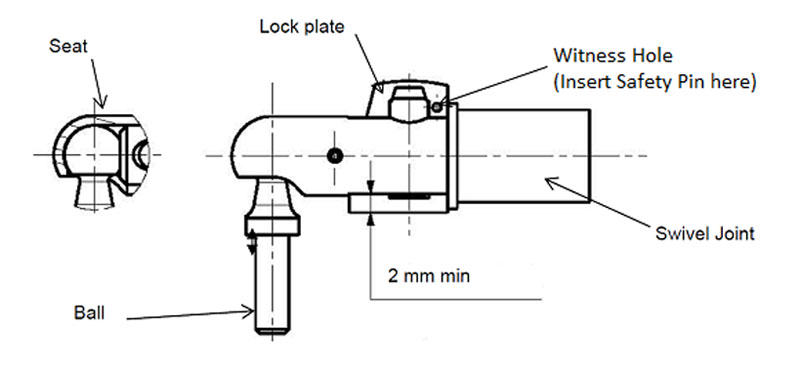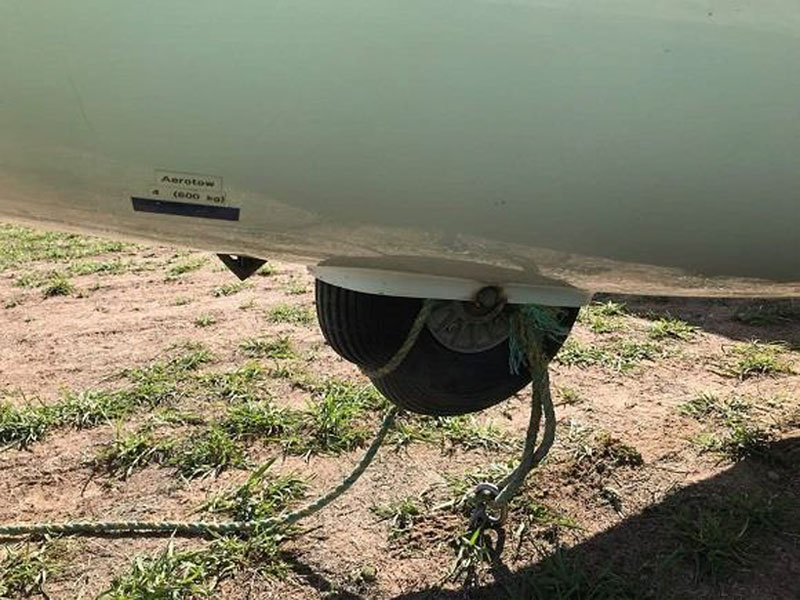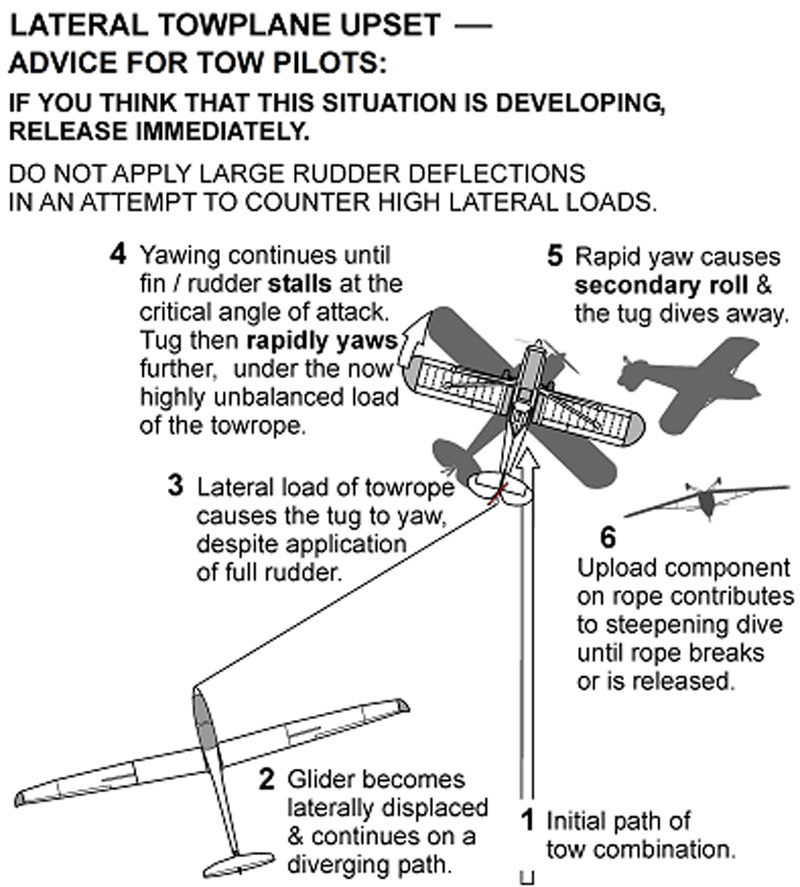Occurrences & Incidents March - July 2020
8-Mar-2020 VSA
Aircraft Control - Hard landing
DG-500 Elan Orion
What Happened
At the end of a soaring flight the inexperienced pilot elected to land long to stop in front of the airfield access gate to the glider hangar. The pilot mishandled the airbrakes during the flare resulting in the gliderballooning, and the aircraft bounced a few times due to misapplication of the controls. The pilot deployed full airbrake to prevent the bounces, which caused the glider to strike the ground heavily on the nose and tailwheel simultaneously. The nosewheel fairing was damaged.
Analysis
The pilot attempted to extend to flight in order to land long by reducing the airbrake setting during the holdoff stage. The pilot did not conduct a minimum energy landing but allowed the glider to touch down while still at flying speed, and this resulted in the aircraft rebounding into the air. The pilot over corrected with elevator. i.e. pitched too far forward, and the aircraft struck the ground several more times before the glider came to rest.
Safety Advice
When small amounts of airbrake are used during the float, and the glider is allowed to touch down at speed,the pilot mut ensure that elevator control inputs are small. This is because the faster and cleaner the aircraft, the greater the pitch sensitivity. Recovery from a bounce should not be thought of in terms of 'control movements', but by reference to the glider's attitude and its position in relation to the ground. In other words, the pilot needs to recover by selecting an attitude which prevents any further climb. Bounces can be avoided by the pilot establishing the glider on the approach at the correct airspeed for the conditions using half or more airbrake. Pilots must endeavour to maintain the approach speed to roundout and aim to touch-down with low energy on the main-wheel and tailwheel simultaneously.
14-Mar-2020 GQ
Fuel Related - Exhaustion
Piper PA-25-235

WHAT HAPPENED
During an aerotow, at around 1200ft AGL, the tow plane's engine stopped. The tow pilot waived-off the glider, which climbed away in a thermal, and landed the tow plane safely on the reciprocal runway at the aerodrome.
ANALYSIS
The tow pilot arrived at the field as the rostered tug pilot and found towing was already in progress. There was a large group of students for training, as well as single-seat aircraft needing launches. The tow pilot was not involved in the initial Daily Inspection but performed their own individual inspection prior to taking over the aircraft. The tow pilot assumed the aircraft had started the day with a full tank of fuel, and this belief was reinforced by the fuel gauge reading full and the flight record showing only one launch had been conducted.
LESSONS LEARNED
The tow pilot stated “The Pilot In Command has the sole responsibility to ensure there is no possibility of fuel starvation. I used methods to calculate remaining fuel that are inaccurate and unreliable, and ignored my feeling that the fuel must be low ... How do we stop it from happening again?. The human part will always be there, but the only way I believe to reduce the risk to the barest minimum is a proper fuel calculation, and write the tacho number down on the tug sheet as a ‘go or no go’ in your pre take-off check. Every tug pilot does one before each tow, even if it is abbreviated, and that check definitely includes fuel. It would also be a safety advantage for the club to install an accurate fuel meter on the bowser. I do not believe the complication of more rules or procedures will help, because those things are already in place, and I simply flew in ignorance.”
SAFETY MESSAGE
Fuel exhaustion is a situation where there is no more fuel onboard. Unlike Fuel Starvation there is nothing to be done about re-establishing the flow of fuel. Most of these occurrences lead to a forced landing. Nevertheless, an ATSB study from 2015 (see Further Reading) showed that fuel exhaustion results in fewer fatalities than fuel starvation. A possible reason for this could be that the pilots involved in fuel starvation scenarios consider more options than just a forced landing, sometimes leading to inappropriate choices and fatal outcomes. Exhaustion occurrences are normally either the result of a gross error in the fuelling of an aircraft before flight, or the result of a number of seemingly minor aspects of fuel planning and management during the flight.
14-Mar-2020 GQ
Flight controls
Astir CS Jeans

What Happened
During the Daily Inspection (DI) one of the aileron’s L'Hotellier coupling safety pins was incorrectly fitted and not securing the fitting as required. The DI was being conducted by a pilot undertaking their first inspection on type. Although the pilot had been briefed on the DI, they choose to seek confirmation of the L'Hotellier coupling system from an airworthiness inspector, as they found the connections for the ailerons and the airbrakes used two differing types of safety locking pins. The inspector confirmed that there were two different types of safety locking pins being used but noticed that the left aileron safety locking pin had been incorrectly fitted and was not in safety. They found the safety pin had not been inserted through the small hole at the top-rear of the locking tab as the designer intended but had been forced around the L'Hotellier coupling and merely clipped together. The safety pin was removed and found to have been bent out of shape. The safety pin was fixed and fitted through the small ‘locking’ hole, and its safety was independently confirmed. Following an independent control check, the maintenance release was signed, and the aircraft returned to service. The Club CFI noted that it was likely that the safety locking clip has been connected this way for a considerable length of time and that the aircraft had been flown in this configuration on several occasions. The CFI found that the aircraft had been signed out by several daily inspectors, which suggested a gap in their knowledge and training. The CFI sent an email to all members alerting them to this problem and some remedial training was conducted.
Safety Advice
The Daily Inspection is required to establish that the glider is fit for flight for that day’s flying operations and certify that in the Maintenance Release. A thorough Daily Inspection is essential to avoid incidents and accidents by finding faults with the glider before it flies. A person holding Daily Inspector authorisation therefore plays a frontline role in incident and accident prevention, and in continuing to keep the glider airworthy... Another good reference is the ‘Daily Inspector's Handbook’ that is available from the GFA Documents Library.overloaded.
15-Mar-2020 VSA
Rope/Rings Airframe Strike
ASK-21

As the slack was being taken-up in the rope for an aerotow launch, the rope caught around a tuft of grass to the side of the runway. When the rope became taut, while still caught in the grass, the wing runner gave the “all out” command. As the tow plane accelerated the rope disengaged from the tuft of grass and became instantly slack. The glider over-ran the slack rope, which then got entangled with the nose wheel. The command pilot in the glider pulled the release but because the rope was wrapped around the front wheel and still connected to the tow plane, the glider continued forward. The command pilot applied the glider’s brake, which alerted the tow pilot to there being a problem and the launch was abandoned. The command pilot reported this “All happened VERY quickly”. This incident highlights the potential hazard of a rope overrun and highlights why a launch should not proceed if the tow rope becomes fouled. The Club’s CFI has raised awareness of this incident and aksed the instructors to ensure wing runners do not allow a launch to proceed if the rope is hindered or fouled.
21-Mar-2020 GQ
Collision with terrain
Ventus-3M
While on a cross-country flight an outlanding became inevitable and the pilot elected to conduct a selfretrieve. The engine failed to start, and during the subsequent outlanding the glider’s port wing contacted long grass causing the glider to ground loop.
Factual Information
The pilot was flying a cross-country sortie in his self-launching glider when conditions deteriorated and an outlanding was likely. At an estimated 1000ft AGL the pilot decided to start the engine to self-retrieve. The pilot reported the engine appeared to raise slower the usual and stated, “I may have been influenced in this feeling by the flashing battery light on the engine controller.” When the pilot tried to start the engine, it only clicked and did not turn over. The pilot then attempted to air start the engine by diving, even though this is not a procedure in the flight manual, but this was unsuccessful as the propeller failed to rotate. During this action the pilot did not have time to fully assess the suitability of paddocks for landing, and the paddock selected had a significant slope. While landing across the slope, and upon flaring for touch down in a wings level attitude, the uphill (port) wingtip caught in grass and the glider turned through 180 degrees.
Analysis
The aircraft is fitted with three LiFePO4 batteries – an engine battery in the nose, a battery in the tail and a battery behind the pilot’s seat. All batteries can power the avionics but only the engine battery will power the engine. The pilot reported that the low-battery light had been illuminating intermittently for some time, even though the battery voltage normally checked at over 13V, and he had already made arrangements to return the avionics controller (the prototype Sn1) to the manufacturer for checking and a software update...
Safety Advice
Batteries - LiFePO4 batteries feature a high discharging current, have a long cycle life and their voltage remains almost unchanged down to about an 80% discharged state. However, when the battery starts running out it drops rapidly. Pilots flying aircraft with these types of batteries need to be aware that a satisfactory voltage check does not guarantee there will be sufficient charge available during flight. Outlanding Incidents - A common reason for powered sailplane outlandings going awry is the pilot’s mindset of expecting the engine to start first time and not having any other plan. GFA training requires pilots to remain within glide range of suitable landing options, and to make the decision to break-off the flight at a sensible height above ground. For pilots of powered sailplanes, including sustainer types, the decision to break off the flight will usually be higher than that for pure gliders. The actual height will be governed by the complexity of the engine starting process and availability of suitable landing options should the engine fail to start. This then allows the pilot sufficient height and time to conduct a safe outlanding should things go
30-Apr-2020 GQ
Powerplant/Propulsion
PIK-20 E
Under investigation. Returning to Mareeba airport from cross country, the pilot started the engine to selfretrieve. The glider was climbed to 6,000ft, which was about 2,000ft above that needed for final glide. While reducing power to cool the engine before retracting the pilot felt a jolt through the airframe and noticed in the rear vision mirror that the propeller tips were broken. The pilot shut down the engine but was unable to open the engine bay doors to apply the propeller brake. With the propeller windmilling, the glide ratio deteriorated markedly and the aircraft rapidly lost height. Eventually the propeller stopped but the engine could not be retracted, and as the glider was pushing into wind it became obvious to the pilot that an outlanding would be needed. The pilot selected a grassed paddock and configured the glider for a landing with the engine extended. The aircraft touched down safely, but during the initial landing roll it struck a rock hidden in the grass and the undercarriage collapsed. The right wing then got caught on the grass and the glider performed a ground loop and came to rest 90 degrees to the direction of travel. The pilot was uninjured, but the glider suffered substantial damage including a broken tail boom. Upon exiting the glider, the pilot inspected the engine and found the mechanism for raising and retracting the engine had detached at the top pivot point where the bolt had fallen out. The pilot found the bolt retaining nut in the engine bay. When the bolt let go the engine pylon moved forward, allowing the propeller tips to contact the small hinged door cover. When the engine stopped, the airflow pushed the pylon back into the engine bay doors and prevented them from opening. The pilot reported that he found the bolt to be in the normal position during the Daily Inspection, but he did not check whether the nut was secure. The incident is being investigated by the Airworthiness Department.
10-Jul-2020 GQ
Other Weather Events
ASK 21 B
What happened
The Club was running an ab-initio training course and the weather bureau was predicating strong crosswinds in the afternoon that would have made it unsuitable for the training being conducted. A decision was made to commence operations at 06:30 to provide a window for training before conditions deteriorated. The first aerotow launch commenced on time and shortly after the glider became airborne the canopy began to fog over. The student, who was flying the glider, lost sight of the tow plane and inadvertently kited through its slipstream. The instructor took control at about 200ft AGL, released from tow and lowered the nose to attain safe speed near the ground. The instructor stated: “I had seen the windsock at the end of the strip go past and knew there was not enough strip to land ahead without going into the paddock at the end of the strip. A tractor had been seen in that paddock before launch so, unsure of its position, and not being able to see in front, only out the clear view, I made the decision to do a 180 degree turn and land in the paddock next to the strip. I commenced a shallow (no more than 20-degree bank) to the left and levelled out preparing to land in the paddock, when the student said she could see the club house. I then got a visual of the clubhouse and moved approximately 30 metres to the left and proceeded to land on runway 30 using the wheel brake to stop very short as I could still not see the other aircraft on the strip.” Following this flight, the instructor halted operations for an hour to allow the air to warm. The instructor noted the temperature of the air at the time was close to the dew point and there was fog about 10kms away.
Comment
A cold canopy that is exposed to slightly warmer or moist air can ‘fog up’. It is likely that the glider moved between different temperature layers as it climbed, and this may have led to a combination of temperatures suitable to allow fog.
Safety Advice
Whilst the above flight successfully turned through more than 180 degrees to land back on the airfield, such turns are not recommended below a height of 300 feet due to the risk of mishandling and low-level loss of control. Although it may be inconvenient, at low level it is safer to minimise the amount of manoeuvring by landing as straight ahead as possible unless terrain features dictate otherwise.g
26-Jul-2020 VSA
Aircraft Control
Piper PA-25 - Twin Astir

Under Investigation. During the aerotow launch and at a height of about 1500ft AGL the student
commenced an exercise to ‘box’ the tow plane’s wake (slipstream). The exercise had been pre-briefed with both the student and tow pilot. The student commenced the exercise from the low tow position and moved the glider quite quickly to the right. As the student began to transition into the high tow position while still out to the right of the slipstream, the tow pilot made a radio call to the crew in the glider advising the glider was displaced too far to the right and that he was having control difficulties – specifically that he was being pulled into a roll to the left. The instructor directed the student to return the glider to the normal low tow
position but in so doing the student allowed a significant bow to develop in the tow rope. The instructor took control of the glider but was unable to prevent the rope from quickly becoming taught, at which point the weak link broke. As the towrope was re-tensioned, the tow pilot reported that this caused an excessive yawing moment and the tow plane commenced an uncommanded roll to the left that he managed to counteract before it became too severe. Upon the weak link breaking, the rope sprang back and draped over the glider’s starboard wing. The student operated the glider’s release and the rope slip off the wing and fell to the ground. Both the tow plane and glider landed safely back on the airfield.































